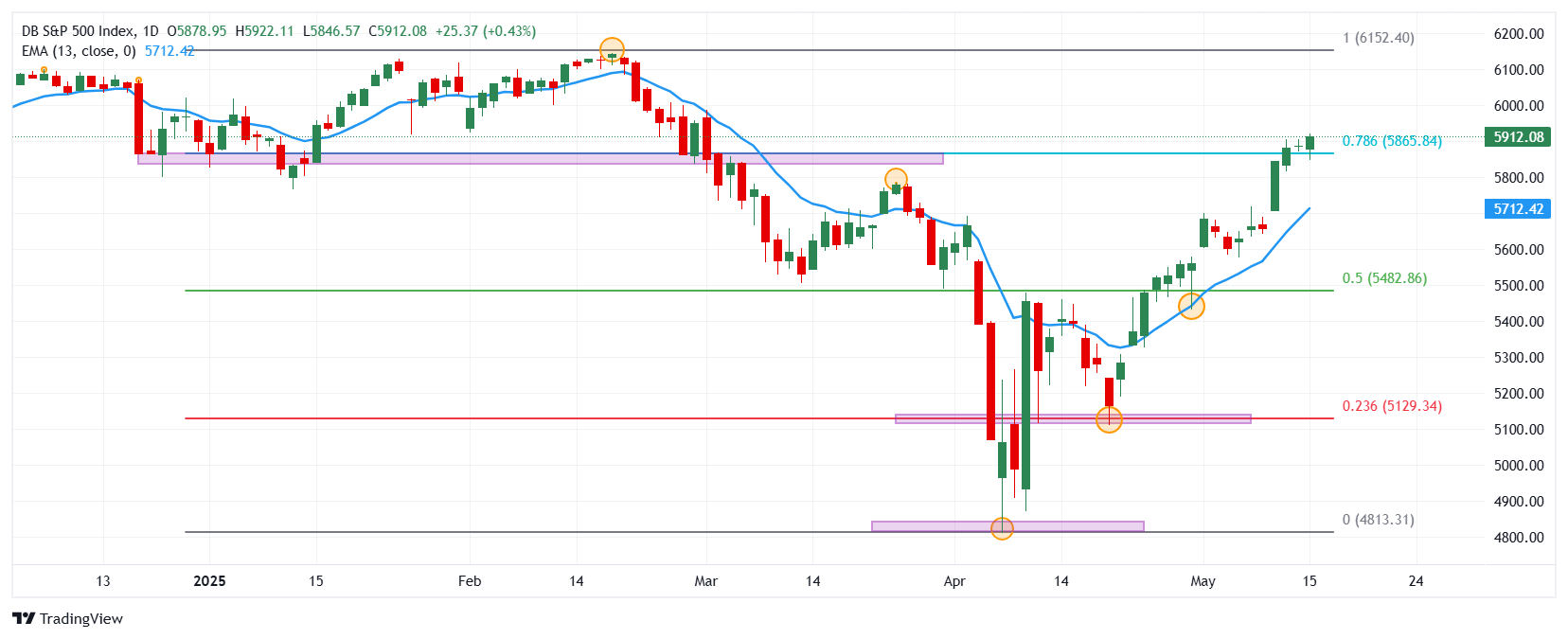- The S&P 500 stock index advances 0.43% on Thursday, reaching maximums of March 3 in 5,922.
- Weekly applications for unemployment were maintained unchanged in 229,000, complying with market expectations.
- The US retail sales rise 0.1% in April, improving analysts projections.
- Steris (Ste) shares rebound 8.52% daily, reaching maximums not seen since August 2, 2023.
- Michael Barr, a member of the Board of Governors of the Fed said that commercial policies cloud the perspectives.
The S&P 500 established a minimum of the day in 5,846, finding buyers who promoted the maximum index of March 3 in 5,922. Currently, the S&P 500 quotes at 5,912, rising 0.43% in the day.
The S&P 500 signs its fourth consecutive day with profits
Based on information from the Labor Department, weekly unemployment subsidy requests remained unchanged by 229,000 in the week that ended on May 10, complying with market estimates.
The production price index increased by 2.4% annualized in April, below the estimated 2.5% and the increase registered in March 2.7%.
The S&P 500 rises 25 points today, winning 0.43%, reaching maximum of March 3 in 5,922, spinning four consecutive upward sessions.
Steris (Ste) titles shoot 8.52% today, visiting maximums not seen since August 2, 2023 in 248.68 $, leading profits in the share index.
The member of the Board of Governors of the Federal Reserve, Michael Barr, indicated that high tariffs expose US companies to significant risks, reviving inflation if supply chains are dismissed.
Levels to be considered in the S&P 500
The S&P 500 formed a short -term support given by the minimum of April 30 in 5.430, in convergence with the exponential mobile average of 13 periods. The following important support is in 4.810, minimum of April 7. Upwards, the key resistance is observed in 6,145, pivot point of February 19.
S&P 500 DAILY GRAPH

S&P 500 FAQS
The S&P 500 is a very often stock index that measures the yield of 500 public companies and is considered a wide measure of the US stock market. The influence of each company on the calculation of the index is weighted based on stock capitalization. This is calculated by multiplying the number of bought shares of the company for the price of the action. The S&P 500 index has achieved impressive yields: 1.00 $ invested in 1970 would have produced a yield of almost $ 192.00 in 2022. The average annual profitability since its creation in 1957 has been 11.9%.
Companies are selected by Committee, unlike other indices that are included based on established standards. Even so, they must fulfill certain eligibility criteria, the most important of which is stock market, which must be equal to or greater than 12.7 billion dollars. Other criteria are liquidity, domicile, stock capitalization, sector, financial viability, quotation time and representation of the sectors of the United States economy. The nine largest companies in the index represent 27.8% of the stock market capitalization.
There are several ways to operate with the S&P 500. Most of the Stred Betting retail runners and platforms allow operators to use contracts per difference (CFD) to make bets on the price direction. In addition, indexed funds, investment funds and quoted funds (ETF) that follow the price of the S&P 500 can be purchased. The most ETF liquid is the ETF of the London Stock Exchange. The most ETF liquid is the State Street Corporation Spy. The Chicago Mercantile Exchange (CME) offers futures contracts on the index and the Chicago Board of Options (CMOE) offers options, as well as ETF, ETF Inverse and ETF leverage.
There are many factors that promote S&P 500, but mainly it is the aggregate performance of the companies that compose it, revealed in their reports of quarterly and annual results. American and world macroeconomic data also contribute, since they influence investors’ confidence, which is positive drives profits. The level of interest rates, set by the Federal Reserve (FED), also influences the S&P 500, since it affects the cost of credit, which is largely depending on many companies. Therefore, inflation can be a determining factor, as well as other parameters that influence the decisions of the Federal Reserve.
Source: Fx Street
I am Joshua Winder, a senior-level journalist and editor at World Stock Market. I specialize in covering news related to the stock market and economic trends. With more than 8 years of experience in this field, I have become an expert in financial reporting.







